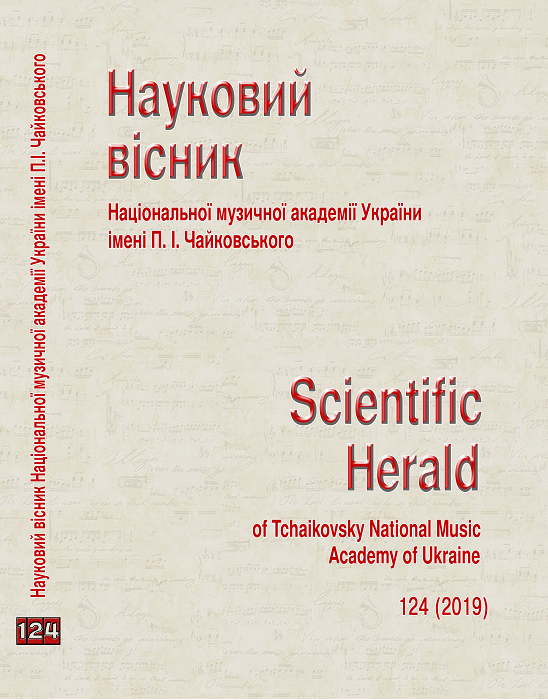Spatio-temporal multidimensionality of the Ukrainian organ symphonies: from sound to genre
DOI:
https://doi.org/10.31318/2522-4190.2019.124.165414Keywords:
organ symphony, Ukrainian organ music, symphony for organ by Y. Lyonko, “White Symphony” by V. Nazarov, “Symphony of creation” by S. Ostrova, spatial-temporal characteristics of the symphony, spatiality and temporalityAbstract
The relevance of the study is because the organ symphonies of Ukrainian composers created at the end of the 20th and the beginning of the 21st centuries have not yet become the subject of a special study. The principal dissimilarity between works with a similar genre name, as well as the growing interest of researchers in the ontological parameters of the symphony genre, makes it possible to endow with the genre-defining functions the ratio of the spatial and temporal characteristics of each symphony for an organ.
Main objective of the study is determination of the spatial-temporal parameters of organ symphonies written by Ukrainian composers in the late twentieth and early twenty-first centuries using the example of three works for organ solos united by the symphony's genre name – the Organ Symphony by Y. Lyonko, the “White Symphony” by V. Nazarov and “Symphony of Creation” by S. Ostrova.
Methodology of the research: system analysis and comparison of three different organ symphonies, the principles of the asymmetry overcoming by the composers are modeled.
The main results and conclusions of the study are that there are three types of concepts of organ symphonies – temporal, spatial and modulating. The time and space of the Ukrainian organ symphonies turns out to be heterogeneous and reflects the views of modern scientific thought about the instability of temporal and spatial parameters of reality, their perceptual dependence. Without breaking with the traditional symphonic concepts, the organ symphonies of Y. Lyonko, V. Nazarov, and S. Ostrova are built on the new principles of interpreting the concept of a symphony as co-sounds. In all analyzed works, symphony as a stable artistic concept ensures the continuity of musical development showing various aspects of life (not just human’s one). The deepening of spatial characteristics occurs primarily with techniques of sonoristics and minimal art. Because of attempts by composers to reveal the metaphysical basis of the name “symphony”, the genre is ontologized, pushing the traditional concept of Man into the background. The basic principles of development are the processes of self-movement of the sound mass, subject to the laws of continuity. The significance of the research is in the perspective of its results to clarify the genre invariant of the organ symphony as a whole, as well as its national identification within the framework of Ukrainian organ music
Downloads
References
Aranovskij, M. (1979). Symphonic Quest (the problem of the symphony genre in Soviet music of 1960–1975). [Simfonicheskie iskanija (problema zhanra simfonii v sovetskoj muzyke 1960–1975 gg.)]. Research essays [Issledovatel’skie ocherki]. Leningrad: Sovetskij kompozitor, 267 p. [in Russian].
Arkadev, M. (1992). Temporary structures of modern European music. [Vremennye struktury novoevropejskoj muzyki]. Moscow: Biblos, 168 p. [in Russian].
Gerasimova-Persidskaya, N. (2012). Music. Time. Space [Muzyka. Vremja. Prostranstvo]. Kyiv: Dukh i Litera, 408 p. [in Russian].
Zin’kevich, E. (1989). Ways of updating the Ukrainian symphony [Puti obnovlenija ukrainskoj simfonii]. New life of traditions in Soviet music [Novaja zhizn’ traditsij v sovetskj muzyke: sb. statej]. Moscow: Sovetskij kompozitor, pp. 52–115 [in Russian].
Voinova, M. and Krivickaja, Y., ed. (2008). From the history of the world organ culture of the XVI–XX centuries [Iz istorii mirovoj organnoj kul’tury XVI – XX vekov: uchebnoe posobie]. Moscow: OOO «Muzizdat», 862 p. [in Russian].
Krivitskaya, Y. (2010). History of French Organ Music [Istorija francuzskoj organnoj muzyki: Ocherki]. Moscow: Kompozitor, 336 p. [in Russian].
Lantsa, R. (2015). Biocentrism. How life creates the universe [Biocentrizm. Kak zhizn’ sozdaet Vselennuju (perevod O. Sivchenko)]. St. Peterburg: Piter, 250 p. [in Russian].
Egorov, B., ed. (1974). Rhythm, space and time in literature and art [Ritm, prostranstvo i vremja v literature i iskusstve: sb. statej]. Leningrad: Nauka, 299 p. [in Russian].
Rovenko, E. (2016). Time in philosophical and artistic thinking: Henri Bergson, Claude Debussy, Odilon Redon [Vremja v filosofskom i hudozhestvennom myshlenii: Anri Bergson, Klod Debjussi, Odilon Redon]. Moscow: Progress-Tradicija, 840 s. [in Russian].
Shherbo,T. (2001). The concept of "symphony." Questions etymology, history, aesthetics and philosophy . [Ponjatie «simfonija». Voprosy jetimologii, istorii, jestetiki i filosofii]. Twelve Etudes about music. To the 75th anniversary of the birth of E. V. Nazaikinsky ]. [Dvenadcat’ jetjudov o muzyke. K 75-letiju so dnja rozhdenija E. V. Nazajkinskogo]. Moscow: Moskovskaja konservatorija, pp. 157–169 [in Russian].
Downloads
Published
How to Cite
Issue
Section
License
Our journal abides by the CREATIVE COMMONS copyright rights and permissions for open access journals.
Authors, who are published in this journal, agree to the following conditions:
The authors reserve the right to authorship of the work and pass the first publication right of this work to the journal under the terms of a Creative Commons Attribution License, which allows others to freely distribute the published research with the obligatory reference to the authors of the original work and the first publication of the work in this journal.
The authors have the right to conclude separate supplement agreements that relate to non-exclusive work distribution in the form in which it has been published by the journal (for example, to upload the work to the online storage of the journal or publish it as part of a monograph), provided that the reference to the first publication of the work in this journal is included.




